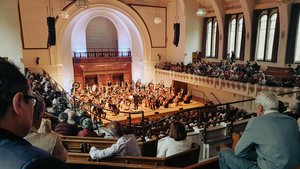Review from the director of Bela Bartok Centre for Musicianship in London

In the past I had the opportunity to experience András Keller’s superb artistry as violinist and quartet leader in live concerts. I recall his performance of Bartók’s string quartets some fifteen or so years ago, and a few years later Kurtág’s Kafka Fragments for soprano and violin. Both concerts delivered the far from easy compositions at the highest possible standard, both were performed in the intimate environment of the Wigmore Hall.
I saw Keller as a conductor only on my computer, with the particular concert streamed from Budapest. Much as I appreciated the streaming opportunity, last Monday’s Cadogan Hall concert was my much-awaited first chance for experiencing Keller as a symphonic conductor in a live concert environment.
There was no way of knowing what to expect. Many excellent instrumentalists have turned to conducting and progressed from high quality soloists to mediocre (or embarrassingly bad) conductors. However, judging by the Cadogan Hall experience, without doubt Keller earned the right to direct a large symphony orchestra. Like the late Zoltán Kocsis – who added sole direction of the Hungarian National Philharmonic Orchestra to his extraordinary piano playing – Keller incorporates his vast knowledge of music and instrumental experience into shaping his orchestra for a great ensemble to reckon with. Like the late Kocsis did, Keller also has the firm support of such heavyweights of our time as Kurtág and Peter Eotvos. Deservedly.
Bartók’s Concerto starts with a subdued motive with the interval of fourths. The orchestra indeed sounded subdued until the flute’s five-bar singing motive (played beautifully and with full assurance by Orsolya Kaczander) brought back normality. This Bartók performance was never harsh – as the Concerto often tends to be – with Bartók’s dynamics meticulously observed. The brass chorale in the second movement, marked mezzoforte, was beautifully sung; the timpani (in the hands of Boglárka Fábry) added the heartbeat but never used aggression. The violas sang their elegiac tune of the third movement with dignity, and then they presented their painful tune (in the fourth movement), possibly expressing longing for one’s country, beautifully. This tune, taken over by the orchestra, has never sounded more beautiful as at this concert, at least to me. By the fifth movement I forgot the orchestra’s difficult journey to reach Cadogan Hall: they were fully up for the immense virtuosity and humour set in Bartók’s score.
Angela Hewitt’s musical background differs from that of András Keller. Yet the chemistry between these two artists is so strong that it was easy to forget the participation of two performers. During the performance of the Mozart piano concerto, I kept hearing only one participant: Mozart. The unity between Hewitt and Keller as well as between Hewitt and relevant sections of the orchestra is exemplary. And then there is the unity between Hewitt and the audience: during the solo piano cadence of the first movement the silence in the auditorium was remarkable; you could have heard a pin drop but none did. The second movement’s interchange between piano and wind was an unbroken continuous song. Like Keller, Hewitt does not employ any sentimentality; she lets Mozart’s harmonies speak for themselves.
On conclusion of the piano concerto, Hewitt graciously thanked the audience for attending in spite of the tube strike. She rewarded us with a Scarlatti sonata, played with informed baroque discipline, integrity and yet with utter beauty.
In Beethoven’s Fifth Symphony the urgent introductory fate motive set the tone for what was an exciting but noble reading of Beethoven’s score. Keller does not employ any cheap shots; he does not allow any self-indulgence. Throughout the symphony he brought out all contrasting elements, such as the second movement’s march set against a sweeping romantic tune, or the gentle introduction of the third movement contrasting the harsh fate motive of the horns. Keller and his team portrayed all emotions in the score with commitment, passion and with integrity without gimmicks. On conclusion, the Cadogan Hall was filled with victorious sounds, prompting the audience to want more.
The two encores were utterly brilliant and emotionally charged: the final movement of Beethoven’s Second Symphony was faster than taken by some other conductors (although a quick search on the Internet shows several fast renderings similar to Keller’s speed) while the performance of Brahms’s Hungarian Dance No.5 in G minor was a masterclass in how to tackle romanticism with taste.
via seenandheard-international.com
